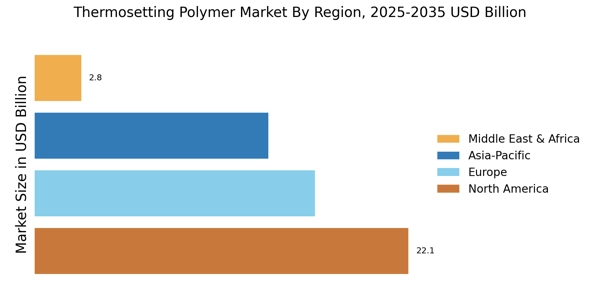Rising Demand in Electronics
The Thermosetting Polymer Market is experiencing a notable increase in demand from the electronics sector. Thermosetting polymers, known for their excellent thermal stability and electrical insulation properties, are increasingly utilized in the production of circuit boards, connectors, and other electronic components. As the electronics industry continues to expand, driven by advancements in consumer electronics and telecommunications, the need for durable and reliable materials becomes paramount. In 2025, the demand for thermosetting polymers in electronics is projected to grow at a compound annual growth rate (CAGR) of approximately 6%. This trend indicates a robust market potential for thermosetting polymers, as manufacturers seek materials that can withstand high temperatures and provide long-lasting performance in electronic applications.
Expanding Aerospace Applications
The Thermosetting Polymer Market is witnessing a surge in applications within the aerospace sector. Thermosetting polymers are favored for their lightweight and high-strength characteristics, making them ideal for aircraft components, including interior parts and structural elements. The aerospace industry is increasingly focusing on reducing weight to enhance fuel efficiency, which aligns with the properties of thermosetting polymers. In 2025, the aerospace segment is expected to account for a significant share of the thermosetting polymer market, with a projected growth rate of around 5% annually. This growth is indicative of the industry's shift towards advanced materials that can meet stringent safety and performance standards while contributing to overall sustainability goals.
Growth in Renewable Energy Sector
The Thermosetting Polymer Market is experiencing growth due to the increasing demand from the renewable energy sector. Thermosetting polymers are utilized in the production of components for wind turbines, solar panels, and other renewable energy technologies. Their durability and resistance to harsh environmental conditions make them suitable for applications in renewable energy systems. As the global focus on sustainable energy solutions intensifies, the market for thermosetting polymers in this sector is projected to expand significantly. By 2025, the renewable energy segment is expected to contribute to a substantial portion of the thermosetting polymer market, with a growth rate of approximately 8%. This trend indicates a promising future for thermosetting polymers as they play a crucial role in supporting the transition to cleaner energy sources.
Innovations in Composite Materials
The Thermosetting Polymer Market is benefiting from innovations in composite materials, which combine thermosetting polymers with reinforcing fibers to create high-performance products. These composites are increasingly used in various industries, including automotive, construction, and marine, due to their superior mechanical properties and resistance to environmental degradation. The market for thermosetting polymer composites is anticipated to grow at a CAGR of 7% through 2025, driven by the demand for lightweight and durable materials. As industries seek to enhance product performance and reduce weight, the adoption of thermosetting polymer composites is likely to accelerate, further solidifying their position in the market.
Regulatory Support for Advanced Materials
The Thermosetting Polymer Market is positively influenced by regulatory support aimed at promoting the use of advanced materials. Governments and regulatory bodies are increasingly encouraging the adoption of materials that enhance energy efficiency and reduce environmental impact. This support is particularly evident in sectors such as automotive and construction, where regulations are being implemented to improve material performance and sustainability. In 2025, the impact of these regulations is expected to drive a notable increase in the use of thermosetting polymers, as manufacturers align their products with compliance standards. This trend suggests a favorable environment for the growth of the thermosetting polymer market, as companies seek to innovate and meet regulatory requirements.


















Leave a Comment